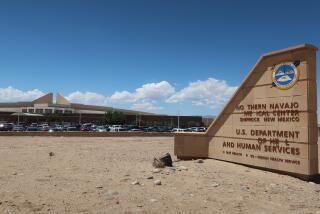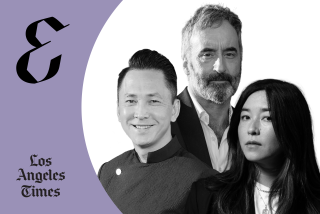Medical Schools Shifting to a Hands-On Approach
- Share via
WASHINGTON — In the sterile setting of a small hospital examination room, a quiet revolution is unfolding in the way doctors are being trained--a revolution that could transform the kind of medical care that Americans can expect to receive in the years ahead.
Dr. Jane Chretien, who practices internal medicine, is telling her young, white-coated student to wash her hands and then place her stethoscope on the bare chest of the patient lying before them, a middle-aged woman complaining of an irregular heartbeat. The student, Quynh Nguyen, complies as Chretien coaches her: “You’re listening for two things, for the rhythm and for murmurs.”
Compared with medical students of decades past, Nguyen is remarkable for her gender and her ethnicity. But more significant still is that in only the first weeks of her medical training, she is already doing what would have been considered unthinkable as recently as a decade ago: She is placing her young hands on real patients.
Quickly Sent to Battle Zone
Ever since the first American medical school opened in 1765, students were thought to need two years of textbook training before they could be trusted in the hurly-burly of the real world. Nguyen and her first-year classmates, like wartime doctors in a MASH unit, are immediately sent to the battle zone to learn about people’s ailments in the flesh.
Nguyen, 23, is the medical student of the 1990s. Born in Vietnam the year before the United States’ withdrawal, reared and educated in Irvine, she is enrolled in George Washington University’s School of Medicine, class of 2001.
Soon, she will be the new doctor of a new century, entering the profession just as economic, social and technological crosscurrents are reshaping it beyond recognition. How she and thousands of other medical students are prepared will help determine the kind of care Americans can expect.
For better or worse, the doctors of tomorrow will operate in an environment of “managed care,” which is burdening them with an obligation to hold down costs even as they try not to skimp on care. In this atmosphere, will the doctors be able to maintain a personal relationship with patients?
At the same time, quantum leaps in the science and technology of making people healthy--or at least keeping them alive--are forcing health professionals to face increasingly thorny ethical questions. Where will tomorrow’s doctors stand on abortion, genetic engineering, end-of-life care and doctor-assisted suicide?
Medical education hears these questions and is trying to respond.
“Medical schools are producing a different kind of doctor,” says Dr. Michael Whitcomb, senior vice president of the Assn. of American Medical Colleges. “What began this process was the introduction and growth of biomedical ethics. It really began to get people thinking about the role of doctors and the relationship of the doctor to the patient and the realities of being a patient and the way decisions are made.”
Nguyen’s experiences over the coming months will offer a front-line glimpse of how medical schools and their students are responding to the new realities. Some clues are already evident from her first weeks on campus.
When Chretien attended medical school more than 30 years ago, beginning students spent their time in the classroom learning the basic sciences. “During the second half of my second year, we were introduced to physical diagnosis,” she says. “It was the first time we were exposed to real-life patients.”
Tougher Challenges Seen for Physicians
Nguyen, by contrast, has been seeing patients, under Chretien’s watchful eye, almost since the day she arrived in Washington. Most medical schools have switched to this approach, although George Washington was one of the pioneers in the 1980s.
“Doctors have a greater challenge than they did in the past to maintain the integrity of their relationship with patients,” Whitcomb says. “It’s positioning students for challenges that doctors who finished their education 15 years ago didn’t have to face.”
Chretien also regards the trend toward hands-on education as a practical response to the nation’s need for more medical gatekeepers--primary care physicians who must be consulted before members of managed care plans can make appointments with specialists.
“For years, we were turning out too many specialists, and there weren’t enough primary care doctors,” Chretien says. “The hope now is that by exposing students to primary care medicine, they will see the excitement of it.”
Quynh Nguyen (pronounced Quinn Hwinn) was born in Vietnam in 1974--a tumultuous time for her family, which actively supported the South.
Hien, her father, was a military commander for a southern army unit. After the fall of Saigon in 1975, her immediate family managed to escape to the United States.
Nguyen was 18 months old when her parents brought her and her four older brothers and sisters to Southern California, where they eventually settled in Irvine. Her father owns a landscaping business, and her mother, Ai, is an electrical technician.
Like many young immigrants, she grew to adulthood immersed in two cultures, living the life of a typical American teenager outside her home while speaking Vietnamese and practicing the Buddhist religion within the home.
“I’ve maintained my culture, and I’m quite proud of who I am,” she says. “I am Vietnamese. But I am also American. When it comes to thinking about who I am--well, I’m both.”
She graduated in biology last year from UC Irvine with an impressive list of academic achievements: Phi Beta Kappa, Golden Key National Honor Society, dean’s honor list for seven quarters and Alpha Epsilon Delta, the premedical honor society.
Mother’s Illness Was a Turning Point
She has long been involved in community service, as a volunteer at a hospice and a home for developmentally disabled children, and as a mentor for children. Last year, she participated in a molecular biology research project, studying the impact of chemicals on fetal respiratory problems.
Her interest in medicine began six years ago, after her mother was found to have thyroid cancer. Nguyen found that the doctors who successfully treated her--who were Vietnamese and who practiced in the local Vietnamese community--were concerned, caring and sensitive to the needs of the family.
“I watched my mother and her doctor interacting, and I realized that this is what really counts, how you as a doctor deal with people on a personal level,” she says. “Everyone says that this kind of medicine just isn’t practiced anymore, but that was not our experience. I saw this--and I realized what kind of doctor I wanted to be.”
Many of today’s physicians find themselves overwhelmed by paperwork and stymied by bureaucratic bean-counters who override their decisions. Some have so soured on their profession that if they had it to do all over again, they wouldn’t.
But Nguyen, who vividly remembers her mother’s experience, has lost none of her youthful idealism. She is leaning toward family medicine or pediatrics, both of which promise doctors that they can maintain long-term relationships with their patients.
“I see myself . . . involved in community service projects . . . working personally with people,” she says. “I think you can really make a difference as a doctor.”
George Washington’s medical school emphasizes “problem-based learning.” When Nguyen is not working with patients, she and her classmates are given case studies and asked to research and diagnose the problems themselves.
One day recently, they are puzzling over the fictional case of “James,” a 6-year-old with sickle cell anemia.
They begin with a script of dialogue between a 28-year-old beginning pediatrician, practicing in a community medical clinic in a low-income and largely minority neighborhood, and James’ mother, who has brought her son in for his preschool checkup. She resists the idea that her son has the disease.
Each of the dozen or so students in the seminar has been assigned to delve into a specific area related to James’ disease: the impact of heredity, for example, or the effect on various body organs. Nguyen’s task was to research the spleen.
All the students share their findings. Dr. Scott Schroth, an internist who teaches the seminar, encourages them to probe and ask questions--and to always be willing to say, “I don’t know.”
“In the real world of medicine, there are things we don’t always understand,” he says. “Even though you sit in a lecture hall and take down many notes, the real world of medicine is not always cut and dried.
“Over the next couple of years, you should always be asking yourself: Why? Why does this work this way? And if this is the way it works, what do we do to fix it, or prevent it?”
Schroth offers the example of one of his own patients--a man of Mediterranean descent who “looks white” and would not necessarily be thought of as a candidate for sickle cell disease, which primarily afflicts blacks and Latinos.
“He went on a ski vacation in Colorado, and the altitude brought on a sickle crisis,” he tells them. “This is how he was diagnosed. These things really happen, guys.”
He adds: “We’re trying to make the sciences more relevant to the real world, trying to give you an idea of the signs and symptoms of what you’re really going to see in your offices someday.”
In Chretien’s office, Nguyen is rapt as the older doctor examines the woman with the irregular heartbeat. Chretien feels the woman’s neck and scrutinizes her eyes, hands and feet, explaining that she is looking for obvious signs of thyroid disease.
“No edema in the feet,” she says, referring to swelling. “No enlargement of the thyroid. How much caffeine do you drink?” Everything appears reassuringly normal. She orders an EKG to be sure.
The patients keep coming: a young, nonsmoking woman who has been congested and coughing for weeks; a 40-something woman with a sore elbow; a middle-aged man with crippling leg cramps.
The woman with the prolonged cold asks Nguyen, “How do you like med school so far?”
“I love it, especially this--the clinical aspect of it,” Nguyen replies.
Observations Called Crucial
Nguyen and Chretien talk in the hall about the patients, but the exchanges are brief.
“We should be able to sit down for at least five minutes after each patient and talk about why we’ve made a certain diagnosis, to give her an opportunity to better understand how all the bits and scraps and pieces fit together,” Chretien says.
“Unfortunately, there is not enough time to see large numbers of patients, which we must do, and also work on a student’s education. She’s not going to learn as much as she could from this, but I do think it’s important for her to start making observations.”
Even at high speed, the experience in the clinic brings home the science that Nguyen is learning in the classroom.
Soon, Nguyen will be expected to take a patient’s history and ask many of the same questions Chretien is asking.
“One very important thing they learn here is how to talk to patients,” Chretien says. “These are people who are sick, angry, upset about things. For many of these students, it is the first time they are actually trying to be helpful to someone who is not too happy with life at the moment.”
Says Whitcomb: “The purpose is to give medical students a context not just for understanding the biological sciences but for beginning to understand a little something of what it means to be a patient, and a little something of what it means to be a doctor.”






